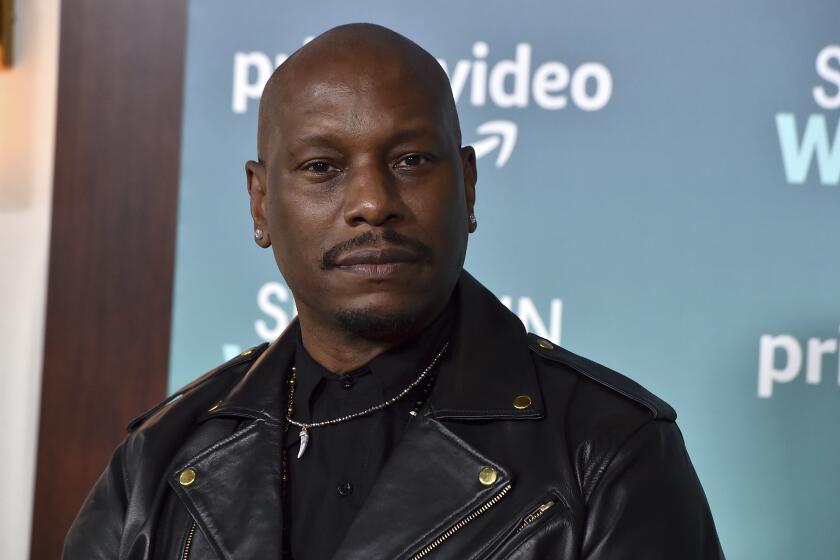In any role, Cagney sparkles
These days we’re often told that stars become stars after a role defines them -- as hard guy, swashbuckler or romantic leading man -- and that audiences accept them only in variations on that role.
But the career of James Cagney, the most protean acting talent in the first three decades of talking pictures, obliterates that conventional wisdom. What drew audiences to him was the way he made acting seem like a form of controlled euphoria. With breakneck ease, he expressed the galvanizing speed and variety -- and the breakneck rhythms -- of 20th-century America.
All this month, you can see him draw a zigzag signature over the American landscape in Turner Classic Movies’ salute to Cagney as its Star of the Month.
Born on New York’s Lower East Side and bred in the equally rough-and-tumble neighborhood of Yorkville, Cagney gave the sleepy world of the early talkies an adrenaline-charged dose of metropolitan energy. He made 53 movies in just over three decades, from the 1930 crime melodrama “Sinner’s Holiday” to Billy Wilder’s 1961 satiric comedy about East and West Berlin, “One, Two, Three.”
Those two films are opposite in every way. That’s why they’re appropriate bookends for the body of Cagney’s work. He was the most versatile Hollywood star of them all. His credits ranged from gangster movies such as 1931’s “The Public Enemy” and 1949’s “White Heat” to screwball comedies such as 1941’s “The Bride Came C.O.D.”
In 1932, Lincoln Kirstein wrote, “When Cagney gets down off a truck, or deals a hand at cards, or curses, or slaps his girl . . . he is, for the time being, the American hero, whom ordinary men and boys recognize as themselves and women consider ‘cute.’ It is impossible to tell whether his handshake is cordial or threatening. He is ‘cute’ -- the way Abraham Lincoln said a certain trapper was ‘cute,’ that is, quick, candid and ambiguous.”
The actor’s surplus energy expressed itself in fellow feeling or psychosis, in youthful high spirits as well as embittered rage and in a 100-proof charm that alternated on screen with homicidal cruelty. Once he started to take his career into his own hands (after widely publicized disputes with Warner Bros.), it was impossible from film to film to predict which Cagney would emerge -- Dr. Jekyll or Mr. Hyde.
The grapefruit he mashed into Mae Clarke’s face in “The Public Enemy” grew to epitomize sexual sadism in the movies; soon afterward, Cagney complained that every script he read contained some wife-beating. But he didn’t squawk when the role honestly called for it. As torch singer Ruth Etting’s brutal lover in the 1955 biopic “Love Me or Leave Me,” he slapped Doris Day so convincingly that he stole the picture clean away from her.
Cagney could be equally convincing playing gentler men. In 1948, he even brought off the role of William Saroyan’s San Francisco saloon saint in “The Time of Your Life.” As Joe, a free-floating philosopher, he tried to save men and women from their own worst instincts instead of cuffing them around. In this one-of-a-kind Cagney movie, he proved that he could convey emotion without resorting to kinetics: He spent most of his screen time sitting down. So great was his banked energy that his chair became the anchor of the film.
But Cagney’s special genius lay in movement. Whether he tripped the light fantastic or shot up the town, this former vaudeville dancer had split-second control. Whether he was in the pink of youth or sporting a sizable middle-aged paunch, he moved as if he were a marionette pulling his own strings -- a punk Pinocchio with kapow. Imagine a wire running from his rump through his neck, giving his torso and head a swiveling motion and letting his feet tap and hands dangle, and you’ve got the basic Cagney posture for both dance and destruction.
He made that posture infinitely flexible. In 1939’s “The Roaring Twenties,” it allowed him to perform a dance of death that sent him ricocheting up and down a set of New York City church steps, as if he were a fatally wounded, hard-boiled Bojangles. In “Angels With Dirty Faces” from 1938, it allowed him to make rapid swaggering gestures -- shooting out his shirt cuffs and half-hitching his shoulders -- while playing gangland god for the Dead End Kids. And it allowed him to win the best actor Oscar in 1942 as George M. Cohan in “Yankee Doodle Dandy,” for tapping like a one-man percussion team and flying like Peter Pan all over the stage, even up the proscenium wall.
What put across Cagney’s inspired showboating was the sheer glee he took in performing. Without a hint of self-consciousness, he seemed to invite audiences to join in. His furtive smiles, feline glances and quicksilver receptiveness, his all-out physicality and angular elegance, became trademarks.
His final feature film role was in Milos Forman’s 1981 “Ragtime”; he died five years later, at age 86. He left the movies as he entered them: a star who created distinct characters. Cagney, who played Lon Chaney in “The Man With a Thousand Faces,” was himself the Man With a Thousand Personalities -- each different, yet because of their agility or fierceness or pride, each still unmistakably Cagney.
Michael Sragow is a film critic at the Baltimore Sun.
More to Read
Only good movies
Get the Indie Focus newsletter, Mark Olsen's weekly guide to the world of cinema.
You may occasionally receive promotional content from the Los Angeles Times.








